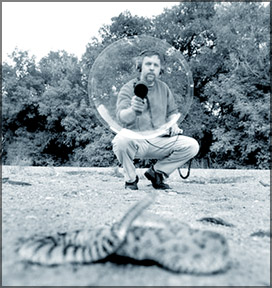Capturing calls of the Wild West
Rattlesnakes aren't to be trifled with, but if you're trying to
collect the sound of every creature in the West that slithers, hops,
flies or flops, distance isn't a luxury you can afford.
"You get yourself in some strange situations," said Jeff Rice, a
soft-spoken University of Utah research librarian who's trying to create
the first comprehensive - and free to the public - archive of natural
sounds in the West.
Minutes later, he was squatting in the hills above Salt Lake City,
training his lightweight parabolic(curved) microphone toward a Great
Basin rattlesnake a few feet away. The snake, caught by wildlife agents
that day in a backyard, offered a few doubtful quiet moments. Finally,
though, it let loose a long dry rattle, both eerie (creepy) and
fascinating, that unmistakably said "keep away."
 |
| University of Utah
researcher Jeff Rice records the rattling sound of a Great
Basin rattlesnake in Salt Lake City to add to his
collection. |
The recording, reduced to a short clip, will be added to the Western
Soundscape Archive, a Web-based sound clearinghouse headquartered at the
university library. Although it's just a year old, the site already has
more than 800 recordings. The goal is to catalogue the nearly 1,200
species of birds, mammals, reptiles and amphibians that roam 11 Western
states. It will also feature "ambient soundscapes" from wild places
across the region.
The sounds will be available to teachers, scientists and anyone else
interested in hearing the odd murmurings of a sage grouse, javelina,
Columbia spotted frog or mountain-dwelling moose.
The landscape recordings could also provide an important audio
snapshot that could be used for comparison later when trying to
understand how animals respond to encroaching subdivisions, oil and gas
development, a warming climate, or other changes.
Repeat photography can reveal changes in a limited area, but repeated
recordings offer broader insights, said Kurt Fristrup, a scientist with
the National Park Service's natural sounds office in Fort Collins,
Colorado. As natural places disappear, so do the animal sounds that
decorate them.
The World Conservation Union estimates that one in three amphibian
species is at risk for extinction. Rice, 41, wants to capture as many on
tape as possible before they're gone. He figures the library has
recordings of about 75 per cent of the 53 frog and toad species in the
states involved.
It has about 70 per cent of the birds and dozens of mammal and
reptile recordings. The recordings, even heard from the safety of a
desktop, can stir something primal in the DNA, a sudden flight response,
for instance, in the case of the rattlesnake.
"Responses to those kinds of sounds are almost reflexive," Fristrup
said. He said Rice's archive could help people learn what animals
they're hearing in the wild, even if they can't see them.
Text and pic: AP
|
